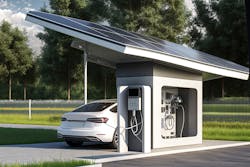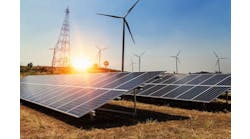Future-Proofing EV Charging Stations
Consider these statistics from the Edison Electric Institute (EEI) that recently released an updated report that details new insights into the coming wave of EV sales and the charging infrastructure needed to support projected EV growth: The number of EVs on U.S. roads is projected to reach 26.4 million in 2030, up from the projected 18.7 million as projected in the 2018 report. Annual sales of EVs will be nearly 5.6 million in 2030, reaching more than 32 percent of annual light-duty vehicle sales in 2030. Compared to the 2018 forecast, this is an increase of more than 1.8 million in annual sales in 2030.
Big questions arise around how millions of new EVs will be charged. The EEI report notes that nearly 12.9 million charge ports will be needed to support the projected 26.4 million EVs that will be on U.S. roads in 2030. And approximately 140,000 Direct Current (DC) fast charging ports will be needed to support the level of EVs expected to be on U.S. roads in 2030.
Power up to meet new fueling demands
The pressure is on as utilities, developers, and fleet managers gear up to prepare for this rapid growth and begin building adaptable systems to better meet changing requirements.
A lot is needed. If we’re talking about utilities only, they require massive new plants and distribution systems to meet increased demand with generators and utility lines, not to mention new substations, new transformers, new everything. Of course, new utility plants and utility upgrades, accompanied by new infrastructure, are expensive and time-consuming and very long-term investments. Securing building permits alone requires time and money. What’s more, many of the costs get passed on to taxpayers.
All these requirements and costs support the case for alternative power sources for EVs, such as distributed energy resources (DER)-supported EV charging stations.
Keep pace with ever-changing legislation and tariffs
In particular, it’s critical to be aware of the most current terms of the U.S. Inflation Reduction Act as they relate to EV tax credits and other policies with very specific requirements. For example, right now new clean vehicles are eligible for up to $7,500 depending on battery size until further guidance is released in the coming months, and used clean vehicles are eligible for a tax credit of up to $4,000.
Be ready for new technologies
The pace of new EV charging technologies arriving on the scene is increasing. This includes evolving charger capabilities such as higher level capacity chargers for industrial trucks and wireless charging that allows EVs to charge without plugging in.
Be smart today and tomorrow
Smart future-proofing starts now with innovative, new EV charging solutions.
Instead of just relying on the utilities, alternative options include enabling EV drivers to charge their batteries via remote distributed energy resources like batteries or solar photovoltaic (PV) solutions and microgrids.
When planning fast-charging EV stations, you also want to ensure you have the ability to apply tariffs directly to charging and EV infrastructure instead of the building as a whole. You also want to design fast-charging EV stations with the flexibility to expand as the need for power increases. For example, make sure you can conduct multi-year analyses to project and understand how needs are likely to evolve over time. Most importantly, you want to generate the energy where it is needed to avoid the expected high costs of a utility system upgrade.
Now on the horizon: DER-supported fast-charging stations for EVs
DER-supported fast-charging stations can deliver optimal electric vehicle fast charging, grid interaction, and value-added grid services as well as provide a foundation for a reliable and sustainable nationwide EV charging network.
An EV project completed by Xendee and Idaho National Laboratory demonstrates how a DER-supported microgrid fast-charging station design platform can allow the EV industry to address, calculate, and assess the lowest cost technology mix for fast charging of EV and truck fleets, as well as optimal capacities for PVs, electric storage, generators, combined heat and power (CHP). The platform also provides insight into the net present value (NPV) or the return on investment (ROI) for the project including the EV fleet loads.
Two test cases help sharpen the focus on the future
As part of this EV fast-charging station project, the team identified charging requirements, load profiles, and power requirements that are particular to fast-charging heavy duty trucks and EV charging at scale. To simulate and validate vast-charing microgrid capabilities, the team defined two cases in California that also assured compliance with functionality and interconnection standards.
One case study represented a grid connected microgrid fast-charging station with 5.83 MW of fast charging capacity. This second one represented an island station with 3.75 MW of fast charging capacity.
As its conclusion, the project integrated three key components:
The development and evaluation of a technical planning and economic analysis tool for the design and implementation of microgrid fast-charging stations
The design of the microgrids’ underlying electric infrastructure
The appropriate testing algorithms to interpret the results
What makes DERs a good solution for EV charging stations
A holistic design and validation framework for DER configurations holds the promise of delivering optimal EV fast charging, grid interaction, and value-added grid services. It also creates a foundation for a reliable and sustainable nationwide EV charging network with a viable financial model for financiers.
The optimal EV fast-charging station incorporating DERs provides:
System operations to minimize costs and maximize revenue
Efficient charging and discharging of electric storage and the EV fleet to minimize overall costs.
Optimized management of EV fleet charging times
Strategic placement of fast-charging stations and local generation resources to mitigate bottlenecks in the utility system
Analysis of the impact of grid outages on the EV charging, costs, and equipment oversizing
Sales of excess energy back to the utility as a revenue stream
Proper electrical engineering for cables and transformers.








